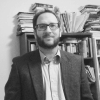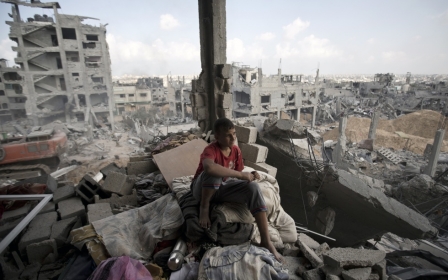Gaza: Where ‘humanitarians’ fall silent

I strongly oppose Western-led wars launched in the name of humanitarianism. They exacerbate the pain of the populations they are supposedly trying to help without resolving underlying socio-political conflicts; indeed, they often make make those worse, as in Libya.
The absurd inconsistency in the ideology of humanitarianism has been exposed in Syria, where, within a single year, Western powers have gone from being on the brink of bombing Syria in the name of protecting Syrians from the Bashar al-Assad government to bombing one of Assad’s main enemies, Islamic State militants.
In regard to Gaza, what follows is therefore not an argument for a Western military intervention against Israel to protect Palestinians. That would be a bad idea because it wouldn’t address the core issues on which the conflict is based and it would in any case be an entirely quixotic exercise. However, a comparison of the way that Gaza has been discussed by advocates of the Responsibility to Protect (R2P) since Israel launched Operation Protective Edge in July with the rhetoric of R2P proponents during the last case in which R2P was applied, the 2011 Libyan war, yields information useful for understanding both how the discourse of humanitarianism operates the attitudes of Western intellectual elites toward Palestinians.
Israel’s 2014 attack on the Gaza Strip subjected the Strip’s residents to what is clearly a humanitarian disaster. When the war was at its peak, the UN estimated that 520,000 people “may be displaced, staying in emergency shelters or with host families”, that 1.5 million Gazans who were not in shelters had “no or extremely restricted access to water”, and that “Gaza’s medical services and facilities remain on the verge of collapse, with hospitals and clinics overwhelmed”. Eleven day into the present ceasefire, a humanitarian emergency persists, as 450,000 Gazans “are unable to access municipal water due to infrastructure damage”, while “Gaza’s health system suffers from chronic shortages in medicine, medical supplies and equipment and there have been limited training opportunities for staff”. Meanwhile, “At least 373,000 children require direct and specialized psychosocial support” because “Children are showing symptoms of increasing distress, including bed wetting, clinging to parents and nightmares.”
The UN reports, in a single sentence that captures the suffering inflicted by Israel, that “the entire population of Gaza has been affected by the conflict and almost all need food and other assistance to recover.”
Moreover, the humanitarian crisis in Gaza preceded the 2014 war. The UN reports that before Israel launched Operation Protective Edge, the siege of Gaza had created a situation in which “around 66 percent of the population of Gaza was receiving food assistance” and 72 percent of households were considered food insecure or vulnerable to food insecurity. Unemployment was at 45 percent overall and 70 percent among people [aged] 20-24, while the “water and wastewater situation in Gaza was … critical”.
Despite these conditions, virtually no advocates of R2P have invoked that principle for Gaza. Yet in the Libyan case, the Global Centre for Responsibility to Protect called for strong international intervention on 22 February, 2011, including an arms embargo on the government of Muammar Gaddafi, sanctions, and the establishment of a no-fly zone over the entire country. As of 20 February, 2011, Human Rights Watch reported that the Libyan death toll was “at least 233”, while on the same day Amnesty International put the figure at 100.
That’s not a trivial death toll but it’s worth noting that nothing in either organization’s document suggested that the Libyan government had engaged in aerial bombardment, attacked medical facilities or schools, or destroyed infrastructure and thousands of homes to the point that hundreds of thousands were either displaced or lacking access to water or some combination of these.
For the sake of comparison, consider that an article from 30 July, 2014, published by Simon Adams, the executive director of the Global Centre for Responsibility to Protect, does not call for anything like the type of intervention the centre advocated in Libya. In fact, it suggests that both sides in Israel-Palestine are at fault to a roughly comparable degree, a completely unsustainable position.
The humanitarian crisis in Gaza was plainly more acute at the time of Adams’ article than it was when his centre was calling for drastic military action in Libya. According a UN report issued two days before Adams’ article was published, 999 Gaza residents had been killed, including 760 civilians, 226 of whom were children. (Keep in mind also, when looking at casualty figures and assessing the severity of the respective crises, that Libya’s population is 6.15 million whereas Gaza’s is 1.8 million or less than one-third of Libya’s).
The UN document also points out that 215,000 Gazans were displaced, 22 medical facilities and 130 schools had been damaged, the “vast majority of the population” had reduced access to water, and on 26 July “313 tons of solid waste” had to be removed “from all areas of the Gaza Strip”. No such conditions existed in Libya at the time the centre was calling for intervention in that country.
What the Gaza-Libya comparison points to is a convergence between the positions taken by R2P advocates and those who wield state power in Western nations. In Libya, the latter’s political-economic interests led the West to seek to replace Gaddafi with a more obedient ally, and R2P’s spokespersons legitimized intervention by the North Atlantic Treaty Organization. By contrast, the West is a party to the horrors to which Gazans are subject, and R2P advocates have offered little in the way of concern for that tormented people.
The next time Western intellectuals advocate that their governments should make war to allegedly protect an at-risk population in the name of universal rights, the invocation of R2P needs to be regarded with profound scepticism and will likely need to be fiercely opposed by people who actually do care about peace and justice.
- Gregory Shupak is an author and activist who teaches Media Studies at the University of Guelph in Canada.
The views expressed in this article belong to the author and do not necessarily reflect the editorial policy of Middle East Eye.
Photo credit: Palestinians are seen among the debris of their destroyed building as the other Palestinians return their homes from safety zone during ceasefire in Rafah, Gaza on 7 September, 2014 (AA)
New MEE newsletter: Jerusalem Dispatch
Sign up to get the latest insights and analysis on Israel-Palestine, alongside Turkey Unpacked and other MEE newsletters
Middle East Eye delivers independent and unrivalled coverage and analysis of the Middle East, North Africa and beyond. To learn more about republishing this content and the associated fees, please fill out this form. More about MEE can be found here.



